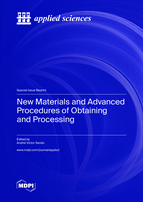New Materials and Advanced Procedures of Obtaining and Processing
A special issue of Applied Sciences (ISSN 2076-3417). This special issue belongs to the section "Materials Science and Engineering".
Deadline for manuscript submissions: closed (31 December 2021) | Viewed by 33737
Special Issue Editor
Interests: materials characterizations; biomaterials; geopolymers; microscopy
Special Issues, Collections and Topics in MDPI journals
Special Issue Information
Dear Colleagues,
This Special Issue is focused on highlighting the most recent contributions in the field of materials and procedures from a broad range of applications, from medical to civil engineering.
The main applications are related to materials involved in environmental engineering, medicine, dentistry, and civil engineering, as well as the procedures for the processing and treatment of various materials.
The studied materials can be from nano to macro scale, involving alloys, ceramics, composites, biomaterials, polymers, and more. We welcome the submission of a variety of manuscripts, from theoretical approaches (modeling or simulation) to advanced insights into materials and procedures.
For this Special Issue of Applied Sciences, it is my pleasure to invite you to submit reviews and articles in the abovementioned areas.
Dr. Andrei Victor Sandu
Guest Editor
Manuscript Submission Information
Manuscripts should be submitted online at www.mdpi.com by registering and logging in to this website. Once you are registered, click here to go to the submission form. Manuscripts can be submitted until the deadline. All submissions that pass pre-check are peer-reviewed. Accepted papers will be published continuously in the journal (as soon as accepted) and will be listed together on the special issue website. Research articles, review articles as well as short communications are invited. For planned papers, a title and short abstract (about 100 words) can be sent to the Editorial Office for announcement on this website.
Submitted manuscripts should not have been published previously, nor be under consideration for publication elsewhere (except conference proceedings papers). All manuscripts are thoroughly refereed through a single-blind peer-review process. A guide for authors and other relevant information for submission of manuscripts is available on the Instructions for Authors page. Applied Sciences is an international peer-reviewed open access semimonthly journal published by MDPI.
Please visit the Instructions for Authors page before submitting a manuscript. The Article Processing Charge (APC) for publication in this open access journal is 2400 CHF (Swiss Francs). Submitted papers should be well formatted and use good English. Authors may use MDPI's English editing service prior to publication or during author revisions.






